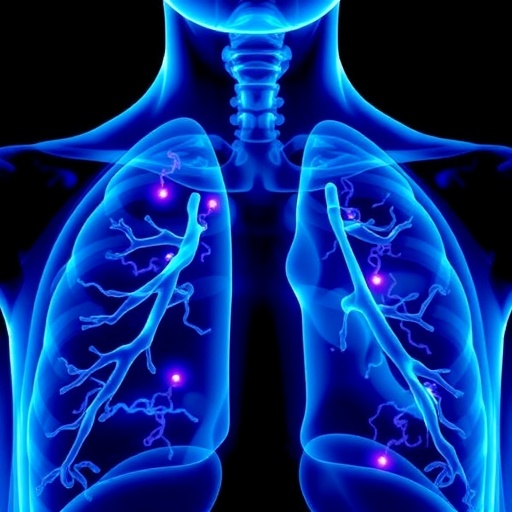In the rapidly advancing field of medical diagnostics, particularly in oncology, the ability to accurately distinguish between benign and malignant tumors remains a paramount challenge. Recent research spearheaded by Jia, Wang, Pan, and co-authors has introduced a groundbreaking integrated proteomic classifier specifically designed for identifying the nature of pulmonary nodules. Their findings, published in the prestigious journal Clinical Proteomics, represent a significant leap forward in the utilization of proteomic technologies for clinical applications.
Understanding the implications of such a classifier is crucial, especially considering the rising incidence of lung cancer worldwide. Traditionally, diagnosing whether a pulmonary nodule is benign or malignant has necessitated invasive procedures like biopsies, which can carry risks and complications. The novel proteomic approach proposed by these researchers illustrates how advanced biomarkers can potentially pave the way for more non-invasive, accurate diagnostics. By analyzing the protein expressions in the tissue surrounding pulmonary nodules, the classifier sorts through complex biological data that may indicate malignancy.
In their study, the researchers harnessed sophisticated proteomic techniques, leveraging high-throughput mass spectrometry to obtain detailed profiles of proteins associated with pulmonary nodules. This mass spectrometry method is renowned for its ability to analyze complex protein mixtures, yielding valuable insights into the pathophysiological conditions of tumors. By studying protein expression patterns, the research team identified specific biomarkers that correlated strongly with either benign or malignant states, thus laying the groundwork for a reliable predictive classifier.
Moreover, the research team emphasized the importance of validation in their approach. They utilized a diverse cohort of patient samples to ensure that the classifier’s effectiveness wasn’t an anomaly but rather a repeatable outcome widely applicable across different demographics. Such meticulous methodological frameworks are essential in translating laboratory findings into clinical practice. The challenge was not solely in developing the classifier but also in ensuring its precision matters where every misdiagnosis could bear significant consequences.
A significant aspect of this study is its holistic approach, integrating data from various proteomic analyses to create a comprehensive classifier capable of making nuanced distinctions between different nodule types. The integration of multiple variables enhances the classifier’s accuracy, setting it apart from traditional diagnostic methods that often rely on singular data points. This multifaceted perspective allows clinicians to consider a broader array of biological indicators, thereby improving diagnostic confidence and patient outcomes.
The research team also highlighted the potential for this classifier to adapt to real-world medical environments. They discussed how integrating this technology into existing healthcare frameworks could streamline diagnostic pathways and reduce the burden on both patients and healthcare providers. As lung cancer screening programs become more commonplace, having a reliable, non-invasive method to assess pulmonary nodules could drastically change the landscape of lung cancer diagnosis and treatment.
Furthermore, the implications of this research extend beyond mere classification; they raise the prospect of personalized medicine. With a deeper understanding of the specific protein profiles associated with individual patients’ nodules, treatment strategies could be tailored more effectively to the tumor’s biological behavior. Such personalization could enhance therapeutic efficacy and minimize unnecessary interventions for benign conditions, allowing healthcare resources to be utilized more judiciously.
The urgency for effective management of lung cancer is underscored by current statistics, which indicate that it remains one of the leading causes of cancer-related mortality globally. Early detection is pivotal for improving survival rates, making innovative classifiers like the one proposed by Jia and colleagues integral to modern oncology. Their work not only contributes to the scientific community’s understanding of lung nodule pathology but also shines a light on potential future directions for research in this area.
As the research community increasingly recognizes the paramount role of proteomics in oncological research, the findings of this study underscore the need for continued exploration and innovation. Future studies may delve deeper into the biological mechanisms underpinning the identified protein markers, potentially revealing novel therapeutic targets. Additionally, the research opens up exciting prospects for collaborations between oncologists, pathologists, and bioinformaticians to refine and enhance the classifier further.
Jia et al.’s multidisciplinary approach exemplifies the collaborative nature of modern biomedical research, where diverse expertise converges to solve complex health challenges. The potential ripple effects of their findings could spark new initiatives focused on biomarker discovery, ultimately pushing the envelope further in the pursuit of better diagnosis and cancer treatment paradigms.
In summary, the integrated proteomic classifier presented in this landmark study not only promises to refine the diagnostic process for suspected lung cancer cases but also contributes profoundly to the overarching field of personalized medicine. It signals a paradigm shift in how healthcare professionals may approach the management of pulmonary nodules, fostering hope for improved patient outcomes and enhanced survival rates in the ever-evolving battle against cancer.
The researchers are optimistic that their findings will instigate further advancements in proteomic technology development and application, leading to even more effective diagnostic tools. As the conversation around cancer treatment evolves, the bioinformatics and proteomics fields will likely play an increasingly vital role, fundamentally reshaping how we understand and tackle malignancies in the years to come.
Subject of Research: Development of an integrated proteomic classifier for distinguishing benign from malignant pulmonary nodules.
Article Title: An integrated proteomic classifier to distinguish benign from malignant pulmonary nodules.
Article References:
Jia, B., Wang, T., Pan, L. et al. An integrated proteomic classifier to distinguish benign from malignant pulmonary nodules.
Clin Proteom 22, 11 (2025). https://doi.org/10.1186/s12014-025-09532-w
Image Credits: AI Generated
DOI:
Keywords: Pulmonary nodules, proteomic classifier, benign, malignant, mass spectrometry, lung cancer, biomarkers, personalized medicine, diagnostics, oncology.




